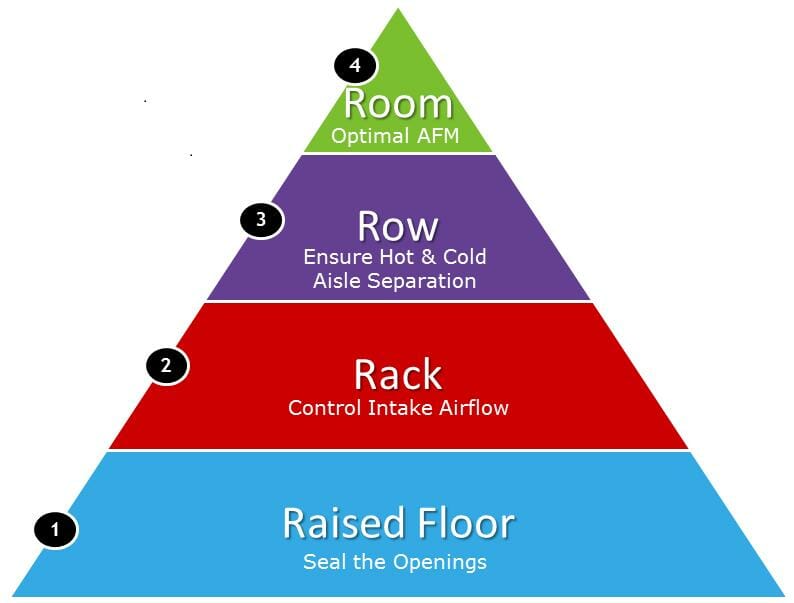4 Steps to Optimizing Computer Room Airflow Management12 min read

It’s no secret that airflow management has become very important and a leading best practice when considering data center efficiency and reliability. But did you know that HOW you implement an airflow management strategy is just as important as the strategy itself, if not more?
With so many airflow management solutions on the market today, such as raised floor grommets, blanking panels, containment, and many others, where do you even start? This is a common dilemma among data center managers today which makes it difficult to determine how to implement an airflow management strategy. This is why we created our 4 R’s Methodology (shown above) — our very own “Hierarchy of Airflow Management Needs” if you will. This process illustrates the proper sequence to implement an airflow management strategy in order to achieve optimal data center efficiency and reliability. This process includes the following steps:
4 R’s Methodology
1. Raised Floor – Manage the open area of the horizontal plane of the raised floor. Seal cable openings using products such as grommets and brushes, and manage perforated tile placement. Check the perimeter walls below the raised floor for unsealed wall or partition penetrations. Sealing these penetrations often requires fire-rated materials.
2. Rack – Close all open space of the vertical plane of IT equipment intakes. Install blanking panels and rack grommets, seal under cabinets, and seal between mounting rails and sides of cabinets.
3. Row – Fill open spaces using under-rack panels or sealing tape, and fill spaces where IT equipment cabinets are missing or where there are gaps between cabinets. In some situations when cabinet densities are high enough or the highest possible efficiency is desired, hot or cold aisle containment may be necessary.
4. Room – Change the cooling infrastructure by raising cooling unit return air temperature set points. Raise set points as high as possible without exceeding the IT equipment intake air temperature maximum. Turn off cooling units or reduce fan speeds for units with variable frequency drives (VFD) or install VFDs.
Why it’s important
It is extremely important that these steps be followed in the correct sequence, as outlined above. If these steps are not followed correctly, it can result in negative effects. For example, let’s say you add full aisle containment to a cold aisle before sealing the openings in the raised floor and controlling intake airflow (1st and 2nd R’s). This can result in an insufficient volume of conditioned air supplied to the aisle, and cooling unit set points being too low. The insufficient volume of conditioned air was caused not by a lack of cooling capacity, but by the poor management of openings in the raised floor. The excessively low cooling unit set points were an attempt to eliminate hot-spots. In this example, if the 1st R had been properly addressed, this rack row level solution would have had the intended impact.
Conclusion
When considering data center efficiency and reliability, airflow management has climbed its way to the top of the list as one of the most effective best practices. However, with so many different airflow management solutions on the market, data center managers are faced with a dilemma when determining what and how to implement an airflow management strategy. This is why we created our 4 R’s methodology, a step-by-step approach to help data center managers optimize airflow management. If followed correctly in the proper sequence, these steps will help will achieve the best results of airflow management; improving data center efficiency and reliability.
1 Comment
Submit a Comment
Airflow Management Awareness Month
Free Informative webinars every Tuesday in June.







Under item #1, it should also be noted that non-directional air flow panels without the use of full cold aisle containment can also significantly increase the amount of bypass air vs directional type air flow products which are much more efficient, and use less CFM to cool the rack load